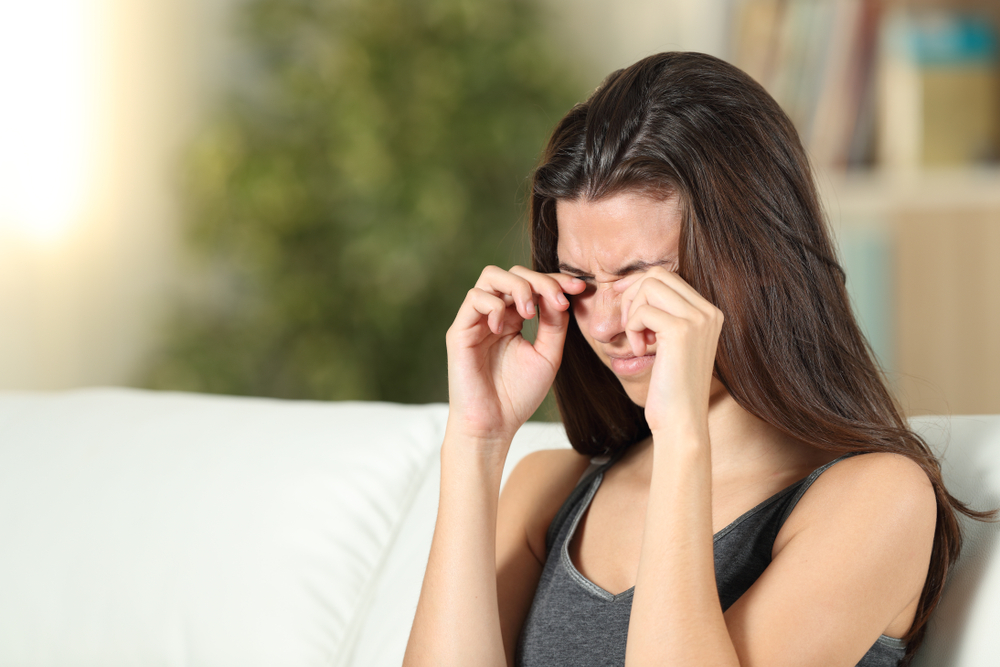If you have dry eye, symptoms like chronic dryness, redness, and grittiness can make simple tasks, like using a computer or reading a book, very uncomfortable. For some people, relief from dry eye can be found through changing their habits around food.
But which foods should you be eating if you have dry eye, and are dietary changes alone enough to combat your symptoms? Keep reading to learn more about whether you can treat dry eye with dietary changes.
What is Dry Eye?

Dry eye is a condition that occurs when the eyes cannot make the volume or quality of tears to keep them comfortably moist. It is a prevalent condition that affects people of all ages.
Healthy tears are composed of three layers: an oily layer, a watery layer, and a mucus layer. Tears that lack a sufficient amount of any of these layers cannot maintain proper eye moisture levels.
Some of the common symptoms of dry eye are:
- A burning or stinging sensation
- Grittiness
- Dryness and irritation
- Feeling like something is in your eyes
- Redness
- Sensitivity to light and glare
- Blurry vision
- Watery eyes
- Mucus in or around your eyes
If you are experiencing dry eye symptoms, you should schedule an appointment with your eye doctor at Batra Vision Medical Group so they can perform a comprehensive eye exam to diagnose your condition.
What Causes Dry Eye?
Dry eye can be caused by several different factors, including:
Environmental Factors
People who live in dry, arid climates are more at risk of developing dry eye. The air in these types of environments can cause tears to evaporate more quickly than in more temperate climates.
If you have allergies, allergens in the air, like pollen, can also increase your dry eye symptoms.
Lifestyle Factors
People who spend extended periods looking at electronic screens may suffer from dry eye. This is because your blink rate decreases when looking at electronics, which prevents the eyes from maintaining consistent lubrication.
Wearing contact lenses can also cause or worsen dry eye, as they prevent oxygen from reaching the cornea, which impacts the tear film.
Physiological Factors
Dry eye can also be caused by meibomian gland dysfunction, which occurs when blockages in the meibomian glands prevent your tear film from getting the oils it needs to properly lubricate your eyes. Age is a significant risk factor for meibomian gland dysfunction, with around 70% of people over the age of 60 having the condition.
What Dietary Changes Can Help Dry Eye?
For longer-lasting dry eye relief, making dietary changes can help support the structures in the eyes that keep your eyes moist and boost overall eye health. Some of the best dietary changes you can make for dry eye relief include:
Eating More Fish

Many fish, including salmon, tuna, halibut, and sardines, are high in omega-3 fatty acids. This nutrient can help ensure healthy tear production and reduce eye inflammation.
Adding Leafy Green Vegetables to Your Meals
Leafy green vegetables, particularly spinach, kale, and Swiss chard, are packed with antioxidants that protect all the structures within the eye.
Snacking Smarter
When considering what to snack on, reaching for things like chia pudding or walnuts can increase your omega-3 fatty acid levels, providing relief from dry eye.
Avoiding Caffeine and Alcohol
This change can be challenging for people who need a cup of coffee to start their day or who like to wind down with a glass of wine, but both alcohol and caffeine are diuretics. Diuretics can significantly affect your body’s overall level of hydration, including the eyes.
Drink More Water
Even if you already drink water throughout the day, if you have dry eye, drinking more water can help maintain healthy tear production. For optimal hydration, you should aim to drink at least 8 cups of water daily, but that amount can vary based on factors like activity and climate.
What Else Can You Do to Ease Dry Eye?
In addition to making dietary changes, there are other lifestyle changes you can make to help lessen the symptoms of dry eye, including:
Using a Humidifier
A humidifier in your home or work can add moisture to the air, helping your eyes stay lubricated and preventing tear evaporation.
Take Screen Breaks
Looking at screens for extended periods of time can lower your blink rate, resulting in your eyes not getting the lubrication they need. To help relieve dry eyes and eye strain, follow the 20-20-20 rule while using a screen; every 20 minutes, look up for at least 20 seconds at an object at least 20 feet away.
Wear Sunglasses

Sunglasses protect your eyes from damaging UV light and shield them from wind and dry air, which can increase tear evaporation.
Use Warm Compresses
If blocked meibomian glands are causing your dry eyes, gently applying a warm compress can help improve oil secretion, promoting a healthy tear film.
While dietary and lifestyle changes can sometimes help relieve dry eye, you should consult your eye doctor if experiencing chronic symptoms. They can diagnose the cause of your dry eye and provide treatment options that can help ease discomfort and restore a healthy tear film.
Treatment options offered at Batra Vision Medical Group include:
- Prescription eye drops
- LipiFlow
- Punctal plugs
- Prokera
Based on the severity of your condition, your eye doctor may recommend one or more of these treatments combined with lifestyle and/or dietary changes to maximize comfort.
Do you want to learn more about ways you can find relief from dry eye? Schedule an appointment at Batra Vision Medical Group in San Leandro, CA, today!

 Follow Us!
Follow Us!